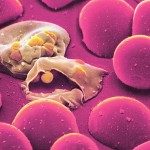Link to Pubmed [PMID] – 8081250
Braz. J. Med. Biol. Res. 1994 Feb;27(2):363-7
Three enzymes have been described in malaria merozoites: a serine-protease and two phospholipases. The parasite serine-protease is necessary for parasite entry into the red blood cell. This enzyme is synthesized by intraerythrocytic schizonts as a glycolipid-anchored membrane precursor, harbouring a preformed serine-protease active site but no detectable proteolytic activity. Detection of the enzymatic activity correlates with the solubilisation of the enzyme by a parasite glycolipid-specific phospholipase C in merozoites. A third enzyme has been detected with glycolipid-degrading activity, presumably a lipase A. These activities participate in a biochemical cascade originating with the attachment of the merozoite to the red blood cell, including the translocation of the phospholipase C to the membrane-bound protease, the solubilisation/activation of the protease and its secretion at the erythrocyte/parasite junction and ending with the entry of the parasite into the host cell. Both the phospholipase C and the lipase A might generate secondary messages in the merozoite. Our current knowledge concerning these enzymes is presented.

